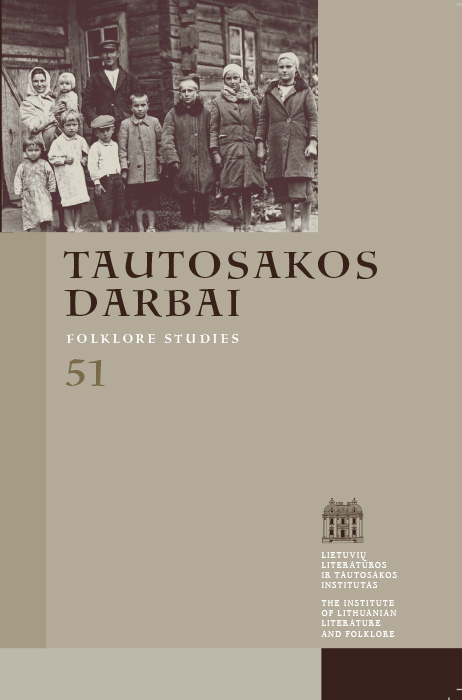From the Vocabulary of the Local Culture: Family Beekeeping
Abstract
The article presents and summarizes the fieldwork data from 2011–2015, focusing on the custom of keeping nominal hives by the family members, still surviving in the family of Janina Arlauskytė-Garbenienė, born in Trumpainiai village (Laukuva parish, Šilalė district) and residing in Vašilėnai (Karklėnai parish, Kelmė district). In the 20th century, the whole beekeeping part of Janina mother’s family – that of Ona Milašiūtė-Arlauskienė followed this custom. It was also partly characteristic to the branch of her father Petras Arlauskis’ family from Senasis Obelynas. The way that Janina’s relatives and some other beekeepers from this region describe beekeeping, clearly indicates that Janina’s way of doing it follows the general pattern of Lithuanian traditional beekeeping. Her family members are engaged in traditional ways of sharing the bees and the honey (Lith. bičiulystė), as well as feeling obliged to help their mother or grandmother in taking care of the bees.
The family way of beekeeping, practiced by Garbenienė closely relates to the Lithuanian notion of happiness and good fortune; it is also a particular way of creating and supporting the family bonds; the same caring and engagement can manifest in the rites of calendar festivals or by other means.
Besides, the data used in the article supports the assumption of Algirdas Julius Greimas maintaining that traditionally, the sons leaving their parents’ household sought beekeeping wives, thus solving the complicated issues of acquiring new property and inheritance. The results of this study differ from those of Greimas in one respect though: in the families of Milašiai and Arlauskiai, the sons-in-law did not engage in beekeeping and the initiative of starting the family could belong to the beekeeping women rather than men. The women’s involvement in beekeeping, so apparent in Samogitia, presents the subject for future investigation.
It is noteworthy, that in Lithuania collective beekeeping is common among not only friends and neighbors, but among members of the family, or relatives. Researchers have so far overlooked this respect, ignoring the fact that beekeeping supplied a bond between generations, between the living and the dead. This determined the sacred core of the family relationship, including kindness, sincerity, love, hard work and mutual respect. According to the research, the placement of beehives in Janina’s apiary corresponds to her family structure
Downloads
Most read articles by the same author(s)
- Vykintas Vaitkevičius, Researching Documentary Heritage. Letters of Lithuanian Partisans , Tautosakos darbai: Vol. 68 (2024): Tautosakos darbai
- Vykintas Vaitkevičius, Revelations of Partisan War in the Letters of Mingėla Family , Tautosakos darbai: Vol. 68 (2024): Tautosakos darbai
- Vykintas Vaitkevičius, Algimantas Stalilionis, Fighting for Lithuanian Freedom in 1918–1920: Volunteers from Pumpėnai , Tautosakos darbai: Vol. 53 (2017)
- Vykintas Vaitkevičius, Fieldwork Trip of the Museologists to Eastern Lithuania in the Summer of 1936 , Tautosakos darbai: Vol. 47 (2014)
- Vykintas Vaitkevičius, Balys Buračas – Both Familiar and Unknown: Fieldwork Notes from 1936 , Tautosakos darbai: Vol. 47 (2014)
